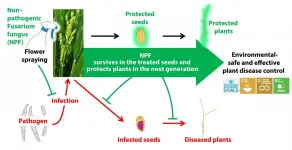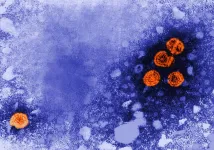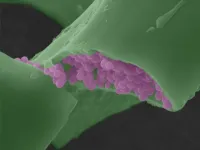(Press-News.org) Researchers have developed a new technique to protect rice seeds against fungal infections that can ruin up to half of all rice crops in the world. The biocontrol method, which involves inoculation of flowers with a different fungus that doesn't cause disease and using seeds harvested from the flower to grow crops, is even better at protecting rice plants from diseases than existing fungicide approaches, and could also be used against similar pathogens that affect other staple crops.
The extremely destructive seedborne bakanae disease, which affects rice plants everywhere in the world that the staple crop is grown, is currently typically combatted with either chemical fungicides or by hot-water treatment of seeds, all of which face growing challenges to their effectiveness.
However, researchers have developed a new anti-bakanae technique that actively encourages the spread of a different, non-pathogenic variety of fungus, that has been shown to outcompete the disease-causing fungus on rice seeds. This biocontrol method not only delivers protection against bakanae disease as effectively as traditional methods, but can also prevent bakanae disease from affecting the seeds, which current techniques cannot.
The researcher's findings are reported in the journal Applied and Environmental Microbiology on January 4, 2021 and was selected as a spotlight paper (https://aem.asm.org/content/87/2/e02789-20).
The pathogenic fungus Fusarium fujikuroi produces gibberellic acid, a plant growth hormone, on rice plants and drives abnormal elongation and etiolation. The affected plants appear pale yellow or white, produce no edible grains, and suffer from weak stems that topple over, hence the name "bakanae," Japanese for "foolish seedling." Losses in the field are substantial wherever the disease emerges, but particularly severe in Asian countries, where the disease can hit 20-50% of crops.
Throughout agriculture, efforts to reduce conventional pesticide use are widespread in order to limit negative impacts on other organisms, but the additional problems that conventional methods of tackling bakanae disease face only add to the need to come up with an alternative. None of these techniques have been very stable, and thus lead to disease outbreaks. They are also not very efficient at combating deeply infected seed stocks. On top of this, existing chemical fungicides also increasingly face challenges from fungicide-resistant strains of the fungus.
The new biocontrol technique, developed by plant pathologists at Tokyo University of Agriculture and Technology, involves spraying rice flowers with a non-pathogenic strain of the fusaria fungus and produces rice seeds carrying the non-pathogenic fusaria. Testing against conventional techniques showed roughly the same level of effectiveness, both against transmission of the disease to seeds, but also transmission among offsprings.
"Investigation under the microscope suggests that the non-pathogenic strain out-competes its cousin, preventing the pathogenic fungi from colonizing the seed, while the growth of the 'good' fungus causes no harm," said Tsutomu Arie, professor and Hiroki Saito, graduate student at the Laboratory of Plant Pathology, Graduate School of Agriculture, Tokyo University of Agriculture and Technology.
As the spread of the good fungus appears to completely replace the bad fungus, the technique should also work on heavily affected seed stocks.
Because rice seeds are usually stored for about six months over the winter before sowing in Japan, the non-pathogenic fusaria in seeds needed to survive at least this amount of time. So to track how long the protection lasted, the researchers genetically tweaked the fungus to make them fluorescent. Six months later, microscopic investigations found that fungal mycelia were still fluorescent, demonstrating they were still there and out competing their "bad" fungus cousins.
The reproductive mechanics of other staple crops in the Poaceae family of grasses that the rice plant belongs to, such as wheat, barley and corn are similar enough that the technique could work on fungal infestations that affect these plants as well. The researchers now aim to test their new method on these crops, as well as on tomatoes, spinach, lettuce, and carrots.
INFORMATION:
Original publication:
Spray Application of Nonpathogenic Fusaria onto Rice Flowers Controls bakanae Disease (Caused by Fusarium fujikuroi) in the Next Plant Generation
Hiroki Saito, Mai Sasaki, Yoko Nonaka, Jun Tanaka, Tomomi Tokunaga, Akihiro Kato, Tran Thi Thu Thuy, Le Van Vang, Le Minh Tuong, Seiji Kanematsu, Tomotaka Suzuki, Kenichi Kurauchi, Naoko Fujita, Tohru Teraoka, Ken Komatsu, Tsutomu Arie
Applied and Environmental Microbiology Jan 2021, 87 (2) e01959-20
DOI: 10.1128/AEM.01959-20
About Tokyo University of Agriculture and Technology (TUAT):
TUAT is a distinguished university in Japan dedicated to science and technology. TUAT focuses on agriculture and engineering that form the foundation of industry, and promotes education and research fields that incorporate them. Boasting a history of over 140 years since our founding in 1874, TUAT continues to boldly take on new challenges and steadily promote fields. With high ethics, TUAT fulfills social responsibility in the capacity of transmitting science and technology information towards the construction of a sustainable society where both human beings and nature can thrive in a symbiotic relationship. For more information, please visit http://www.tuat.ac.jp/en/.
The new therapeutic approach is based on shutting down the viral hepatitis B genome located in the nucleus of infected liver cells. Upon infection of the liver cell, the viral genome is transformed inside the nucleus into a closed circular DNA molecule. This deoxyribonucleic acid is a stable molecule known as covalently closed circular DNA (cccDNA) and serves as the template for the production of new viruses. The cccDNA represents the central reservoir of the hepatitis B viruses and enables their persistence in the liver. The virologist Prof. Dr. Maura Dandri and her team at the UKE managed to prevent the HBV-cccDNA from producing further viruses in the animal model.
The point of attack of their ...
Treating equine donor stem cells with a growth factor called TGF-β2 may allow them to avoid "tripping" the immune response in recipients, according to new research from North Carolina State University. The work could simplify the stem cell treatment process for ligament and tendon injuries in horses, and may also have implications for human stem cell therapies.
Mesenchymal stem cell therapy is a promising avenue for treating musculoskeletal injuries - particularly tendon and ligament injuries - in horses. Mesenchymal stem cells are adult stem cells found in bone marrow that act as repair directors, producing secretions that recruit paracrine, or healing, factors to the site of injury.
Just as blood cells have "types," ...
Gels are formed by mixing polymers into fluids to create gooey substances useful for everything from holding hair in place to enabling contact lenses to float over the eye.
Researchers want to develop gels for healthcare applications by mixing in medicinal compounds, and giving patients injections so that the gel releases the active pharmaceutical ingredient over a period of months to avoid weekly or daily needle sticks.
But standing in the way is a problem that's as easily understandable as the difference between using hair gel on a beach versus in a ...
Virtual 'exergaming' has become a popular way to exercise - especially among younger people - since the release of virtual reality (VR) fitness games on consoles such as Nintendo and Playstation.
But while VR is undoubtedly raising fitness games to a whole new level, researchers at the University of South Australia are cautioning players about the potential side effects of VR, particularly in the first hour after playing.
In a new study published in the Journal of Medical Internet Research, UniSA researchers investigated the consequences of playing one of the most popular VR exergames - Beat Saber* - finding that one in seven players still ...
Catalysts are key materials in modern society, enabling selective conversion of raw materials into valuable products while reducing waste and saving energy. In case of industrially relevant oxidative dehydrogenation reactions, most known catalyst systems are based on transition metals such as Iron, Vanadium, Molybdenum or Silver. Due to intrinsic drawbacks associated with the use of transition metals, such as rare occurrence, environmentally harmful mining processes, and toxicity, the fact that pure carbon exhibits catalytic activity in this type of reaction and thus has high potential as a sustainable substitution material is of high interest.
To date, the development of carbon-based catalysts for oxidative dehydrogenation reactions may be divided into two ...
UCC palaeontologists have discovered new evidence that the fate of vertebrate animals over the last 400 million years has been shaped by microscopic melanin pigments.
This new twist in the story of animal evolution is based on cutting-edge analyses of melanin granules - melanosomes - in many different fossil and modern vertebrates, including fish, amphibians, reptiles, birds and mammals. Melanin and melanosomes have traditionally been linked to outermost body tissues such as skin, hair and feathers, with important roles in UV protection and stiffening of tissues. Analyses of where different animals store melanin in the body, however, show that different vertebrate groups concentrate melanin in different organs, revealing ...
Ultrasound is not only used as an imaging technique but targeted pulses of ultrasound can be used as a highly accurate treatment for a range of brain diseases, for which there were previously only limited treatment options. Over the last few years, several revolutionary techniques of this kind have been developed, primarily in Toronto but also at MedUni Vienna. The Viennese technique improves brain functions by externally activating neurons that are still functional. Improvements can be expected in various neuropsychiatric brain diseases such as Alzheimer's, Parkinson's, stroke, Multiple Sclerosis, and neuralgia. A review jointly written by ...
Researchers at NUI Galway have identified genomic signatures in women developing the most common type of breast cancer that can be associated with long-term survival. The NUI Galway team analysed the genomes of breast cancer patients to look for associations with survival rates using advanced statistical techniques.
Carried out by Lydia King during her studies in NUI Galway's MSc in Biomedical Genomics programme, the research has been published in the international journal PLOS ONE.
Early detection by national screening programmes and timely treatment for patients diagnosed with "luminal" types of breast cancer have resulted in excellent prognoses with survival rates of over 80% within five years of treatment. The challenge of long-term survival ...
FOOD SCIENCE Sweden takes first, Denmark second and Norway lags at the bottom when it comes to how much organic food is served in canteens, kindergartens and other public sector workplaces across the three Nordic nations. This, according to the results of a new report by the University of Copenhagen. The report details plenty of potential for expanding the conversion to organic food service in the Danish public sector--a topic of discussion across the EU at the moment.
Plate with potatoes and beef
The governments of Denmark, Norway and Sweden are all keen on ramping up the amount of organic food ...
The FinnBrain research of the University of Turku has demonstrated for the first time that the stress the father has experienced in his childhood is connected to the development of the white matter tracts in the child's brain. Whether this connection is transmitted through epigenetic inheritance needs further research.
Evidence from multiple new animal studies demonstrates that the changes in gene function caused by environment can be inherited between generations through gametes. In particular, nutrition and stress have been proven to cause these types of changes. However, these do not alter the nucleic acid sequence of ...



